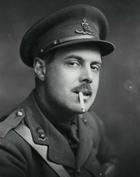
Wyndham Lewis was born in 1882 aboard a yacht, in waters of the Canadian province of Nova Scotia, of North American father and British mother. His parents moved to the United Kingdom, where Lewis received his artistic training at the Slade School of Art, University College London, before devoting himself to travel throughout Europe and study art in Paris. Back in England, in 1909, he published his first work, an account of his travels through Britain, in the English Review directed by Ford Madox Ford. Later, in 1911, he founded with some other young painters the Camden Group, and the following year he made a series of illustrations for the Helm of Athens, by Shakespeare, exhibited in 1912 at the Grafton Galleries in London and then compiled in a folder by Cube Press. That is how he came in contact with the members of the Bloomsbury group. Between 1913 and 1915, and after various alliances and disagreements with artists such as Clive Bell, he developed a peculiar style of pictorial abstraction, which Ezra Pound baptized as "Vorticism", and which would reach its most perfect expression in the founding of Blast magazine. When the First World War was declared, Lewis was assigned to the western front as second lieutenant of gunners. After the third battle of Ypres, in 1917, he was designated "artist of war" by the British and Canadian governments. His first novel, Tarr, considered one of the key titles of the modernist movement, appeared in book form in 1918, after being serialized in 1916 and 1917 in the prestigious The Egoist. Lewis would later document his experiences of this time in Bursts and Bombings (1937). After his theoretical book The Caliph Design (1919), he seemed to take a break, from which he returned to the first line of British literature with forces that no longer left him. In 1926 he began, with The Art of Being Ruled, a work essay that culminates in his most important philosophical book, Time and Western Man (1928). In 1930 his novel The Monkeys of God appeared (soon to be published by Impedimenta), a satire on the London literary scene. In 1931 he published a critical essay, Hitler, in which, in the style of many intellectuals of the time (like Churchill himself), he made a defense of the future German dictator. Later, once Hitler came to power, Lewis published The Hitler Cult (1939), in which he firmly abjured his views of a decade earlier. Even so, Lewis was already politically condemned. In 1951 he became blind because of a venereal disease that had been dragging on for years. In his last years he concentrated almost exclusively on writing. Wyndham Lewis died in 1957.




